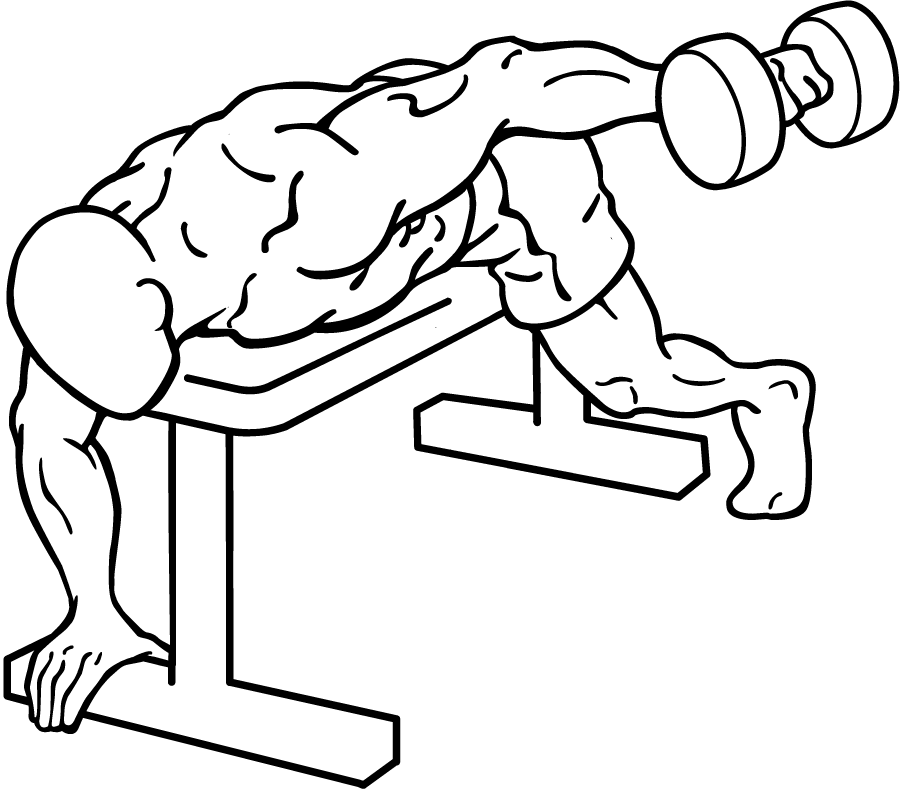Last Updated on December 17, 2014
The lying one-arm rear lateral raise is an effective exercise for building and strengthening the shoulder muscles, specifically targeting the posterior deltoids (rear delts). It’s an ideal addition to any upper body workout for improving shoulder definition, stability, and posture. With a dumbbell and a flat bench, this exercise isolates the back of the shoulder, helping to build a well-rounded look and strength. In this guide, we’ll cover everything you need to know to perform the lying one-arm rear lateral raise correctly, discuss its benefits, provide variations, and share advanced tips for maximizing your shoulder gains.
Why the Lying One-Arm Rear Lateral Raise is Essential for Shoulder Development
- Targets the Rear Deltoids
The rear delts are often underdeveloped compared to the front and middle deltoids, which can create muscular imbalances. This exercise isolates the rear delts, helping to improve shoulder symmetry and overall aesthetics. - Improves Shoulder Stability
Strong rear delts play a crucial role in shoulder stability, especially for pressing movements. Incorporating this exercise can help protect your shoulder joints and reduce the risk of injury. - Enhances Posture
Many people tend to have forward-rounded shoulders due to weak rear delts and tight chest muscles. Strengthening the rear delts can counteract this by pulling the shoulders back, leading to improved posture and alignment. - Reduces Shoulder and Neck Pain
Strengthening the rear delts can help alleviate shoulder and neck pain caused by muscular imbalances and poor posture, providing both functional and aesthetic benefits. - Enhances Upper Body Definition
Defined rear delts contribute to a well-rounded shoulder appearance, adding depth and balance to your physique. This exercise sculpts the back of the shoulders, enhancing overall upper body definition.
How to Perform the Lying One-Arm Rear Lateral Raise: Step-by-Step Guide
Follow these steps to perform the lying one-arm rear lateral raise with proper form and control for maximum effectiveness:
1. Set Up on a Flat Bench
Position yourself face down on a flat bench, ideally high enough that your arms can hang down freely towards the floor. This setup ensures a full range of motion for the shoulder.
2. Grip the Dumbbell with One Hand
Place a dumbbell at your side within reach. Grasp the dumbbell in one hand with your palm facing inward, and use your other hand on the floor or the bench for support and stability.
3. Lift the Dumbbell to Shoulder Height
Exhale as you lift the dumbbell by raising your arm straight out to the side. Keep a slight bend in the elbow to avoid joint strain, and focus on lifting until your upper arm is parallel to the floor.
4. Control the Descent
Inhale as you slowly lower the dumbbell back to the starting position. Use a controlled, steady movement to keep tension on the rear delt and avoid using momentum.
5. Repeat and Switch Sides
Complete your desired number of repetitions, then switch arms and repeat the movement on the opposite side.
Tips for an Effective Lying One-Arm Rear Lateral Raise
- Keep Your Back Straight
Ensure your back is flat and supported on the bench throughout the movement. This stable position helps you focus on isolating the rear delts without involving other muscles. - Avoid Using Momentum
Lift and lower the dumbbell in a slow, controlled manner. Using momentum reduces the effectiveness of the exercise and can put unnecessary strain on the shoulder joint. - Engage Your Core
Even though you’re lying down, keep your core engaged to help stabilize your upper body. This stability ensures a more controlled movement and better muscle engagement. - Use a Moderate Weight
Start with a lighter weight, as heavy loads can compromise your form and shift focus away from the rear delts. Gradually increase the weight as you master the movement. - Focus on the Mind-Muscle Connection
Concentrate on the rear delt contracting with each lift. Visualizing the target muscle working can improve your form and boost results.
Common Mistakes to Avoid
- Overusing Momentum
Swinging the dumbbell or using momentum can take tension off the rear delts, reducing the exercise’s effectiveness. Focus on a controlled lift and descent for optimal results. - Lifting Too High
Lifting the dumbbell above shoulder height can place unnecessary strain on the shoulder joint and reduce rear delt engagement. Aim to lift until your upper arm is parallel to the floor. - Locking the Elbow
Keeping the elbow completely straight can increase strain on the joint. Maintain a slight bend in the elbow for a more natural and safe movement. - Inconsistent Core Engagement
Allowing your torso to shift or rotate reduces isolation of the rear delts. Keep your core tight and maintain contact with the bench for stability. - Using Excessive Weight
Starting with a weight that’s too heavy can lead to poor form and overuse of supporting muscles. Begin with a manageable weight and focus on proper form.
Variations of the Lying One-Arm Rear Lateral Raise
To keep your shoulder workouts engaging and to challenge your rear delts, try these variations of the lying one-arm rear lateral raise:
- Standing One-Arm Rear Lateral Raise
Perform the rear lateral raise while standing, using a slight bend in your torso. This variation allows for more movement but requires greater core stability and control. - Seated One-Arm Rear Lateral Raise
Sit on a bench, bend slightly forward, and perform the rear lateral raise from a seated position. This setup reduces lower body involvement and focuses on the upper body. - Cable Rear Lateral Raise
Use a low cable pulley to perform the exercise with constant tension on the rear delt. This variation allows for a smoother, controlled movement and keeps tension on the muscle throughout the range of motion. - Incline Bench Rear Lateral Raise
Set an incline bench to 45 degrees and perform the raise from this angle. This modification further isolates the rear delts and prevents other muscles from assisting in the movement. - Two-Arm Rear Lateral Raise
Instead of using one arm, perform the exercise with both arms simultaneously. This version is time-efficient but requires more shoulder stability and strength.
Incorporating the Lying One-Arm Rear Lateral Raise into Your Workout
Here’s how to integrate the lying one-arm rear lateral raise into your shoulder or upper body routine effectively:
- Strength Training
For strength, aim for 3–4 sets of 6–8 reps with a moderate weight. This low-rep range allows you to challenge the rear delts without compromising form. - Hypertrophy (Muscle Growth)
To increase muscle size, perform 3–4 sets of 8–12 reps. This rep range creates the right amount of muscle tension needed for growth and definition. - Endurance and Tone
For endurance and toning, perform 2–3 sets of 15–20 reps with a lighter weight. This high-rep range builds muscle endurance and improves definition without adding bulk. - Use as a Finisher
End your shoulder workout with the lying one-arm rear lateral raise for a final burnout. Perform 2–3 sets of 12–15 reps to fully exhaust the rear delts and build definition. - Pair with Compound Shoulder Exercises
Combine this exercise with compound movements like shoulder presses or upright rows for a comprehensive shoulder workout that targets all three heads of the deltoid.
Safety Tips for Performing the Lying One-Arm Rear Lateral Raise
- Start with Light Weights
Use a light weight to master the form and ensure that the rear delts are fully engaged. As your form improves, gradually increase the weight. - Focus on Elbow Position
Keep a slight bend in your elbow to reduce joint strain and make the movement more natural. Avoid locking out or hyperextending the elbow. - Engage Your Core
A stable core prevents unwanted movement in your torso, which helps isolate the rear delts. Engage your abs and glutes for added support. - Avoid Lifting Too High
Lifting the dumbbell beyond shoulder height places unnecessary strain on the shoulder joint. Aim for shoulder level to maximize rear delt engagement and reduce joint stress. - Progress Gradually
Avoid adding weight too quickly. Building shoulder strength and stability takes time, and gradual progression reduces the risk of shoulder injury.
Frequently Asked Questions
Q1: Can beginners perform the lying one-arm rear lateral raise?
A: Yes, this exercise is suitable for beginners who want to strengthen their rear delts and improve shoulder stability. Start with a light weight and focus on proper form.
Q2: How often should I include this exercise in my routine?
A: Include this exercise in your shoulder routine once or twice a week, allowing at least 48 hours between sessions for muscle recovery.
Q3: Should I do this exercise with a cable machine?
A: Yes, cables can be used for this exercise as well. The cable provides constant tension, which can increase muscle activation and improve control.
Q4: Can this exercise replace other rear delt movements?
A: While the lying one-arm rear lateral raise is excellent for rear delt isolation, it’s best to combine it with other rear delt exercises like face pulls, reverse flyes, or bent-over lateral raises to ensure a well-rounded shoulder workout. These additional exercises target the rear delts from slightly different angles, leading to comprehensive development and improved shoulder strength.
Q5: How does this exercise compare to a standing rear lateral raise?
A: The lying one-arm rear lateral raise minimizes momentum and body sway, allowing for better isolation of the rear delts compared to a standing variation. It’s a great choice for those who want to focus solely on the rear delts without engaging the lower back or core as stabilizers.
Advanced Tips for Maximizing Results from the Lying One-Arm Rear Lateral Raise
- Slow Down the Eccentric Phase
Take 3–4 seconds to lower the dumbbell back to the starting position. This slower eccentric (lowering) phase increases time under tension, which is essential for muscle growth and control. - Add Pause Reps for Increased Intensity
Pause briefly at the top of each lift when your arm reaches shoulder height. This pause intensifies the contraction in the rear delt, challenging the muscle further and enhancing strength gains. - Incorporate Drop Sets
After reaching failure with a given weight, reduce the load by 20-30% and continue with additional reps to failure. Drop sets are an excellent technique to fully fatigue the rear delts and promote muscle growth. - Vary Rep Ranges
Alternate between low, moderate, and high rep ranges each week to keep the rear delts challenged. For example, use heavier weights with lower reps one week, and switch to lighter weights with higher reps the next. - Focus on the Mind-Muscle Connection
Concentrate on the rear delts working during each rep. Visualizing the rear delts contracting helps improve the mind-muscle connection, leading to better muscle activation and results.
Wrapping Up: Strengthen and Sculpt Your Shoulders with the Lying One-Arm Rear Lateral Raise
The lying one-arm rear lateral raise is a highly effective exercise for targeting the rear deltoids, which are essential for balanced shoulder strength, stability, and aesthetics. Whether you’re looking to build stronger shoulders, improve your posture, or enhance your upper body definition, this exercise deserves a spot in your routine.
By focusing on proper form, starting with a manageable weight, and incorporating variations and advanced techniques, you can maximize the effectiveness of this rear delt exercise. Consistent effort and attention to detail will help you achieve well-rounded, powerful shoulders that not only look impressive but also support your overall shoulder health and performance.
Include the lying one-arm rear lateral raise in your shoulder workouts, and watch your rear delts grow stronger and more defined over time. With the right approach, this exercise can help you reach your shoulder development goals, making it an essential component of a balanced upper body workout plan.








